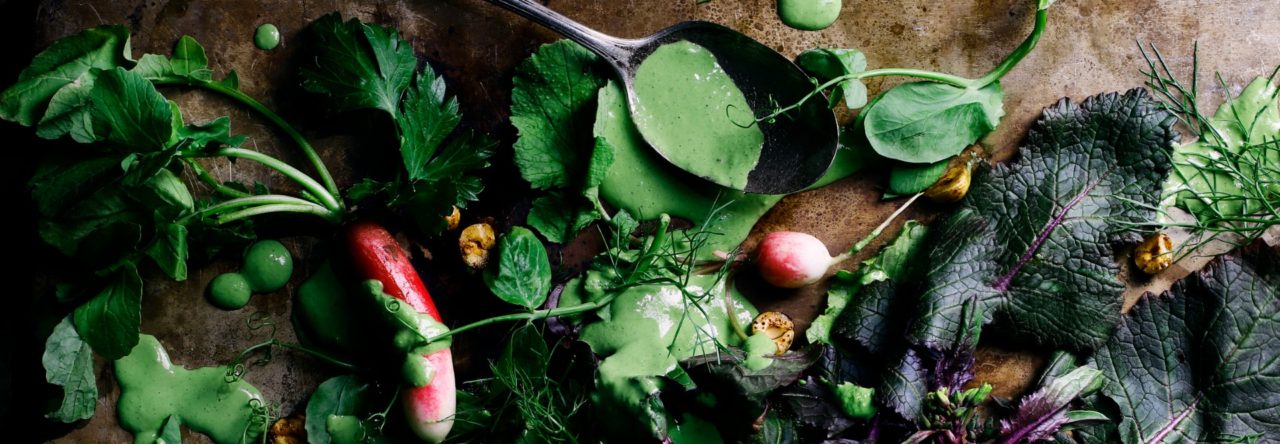Sourdough Teff Crepes (Injera)
Makes about 7 to 8 ten inch crepes
UPDATE DEC 14:
I’m changing the proportions in the recipe to make a thicker batter. If you’ve already started your batter, do the following:
Thoroughly stir in 1/2 cup bread flour into the batter until completely blended
For those that have not started, proceed as directed below.
P.S. I’m also cutting down on the total fermentation time.
If you’ve dined in an Ethiopian restaurant, injera very well may have been the most unforgettable dish. Understated and literally underneath all those spicy, savory stews is this humble, chewy pancake-like bread. Spongey and slightly sour, yet sturdy enough to grab onto a saucy stew or melting chunk of vegetable, injera is the soul of Ethiopian cuisine to many of us.
Making relatively authentic injera at home seem like a challenge at first; I’ve seen many shortcuts, but I think putting a little extra time into the batter results in the best tasting stuff you can make yourself. And it doesn’t really require a whole lot of effort, just some planning and a whole lot of relaxing.
These injera use a three-day long fermentation process. That sounds like a lot of work, but really the batter just sits on your countertop doing absolutely nothing that involves you; while you’re at work or sleeping, the yeast party that’s happening in the batter adds loads of flavor and valuable little bubbles that will give the injera it’s characteristic spongy texture. Your job, the actual mixing and cooking of the batter probably takes less than 45 minutes at most. If you discover you love making injera, you can even make a double batch of batter, save some of the batter as a starter and keep it going in the refrigerator until the next time you need some.
Your homemade injera will be different from the pale grey crepes you’re used to seeing in most restaurants, which likely use very little, or any, teff flour. Teff is the traditional African grain that injera is made from; teeny seeds that come in many shades of brown, white or tan that are highly nutritious and that can be ground up into a smooth wholesome flour. This recipe uses a high proportion of teff flour for a deep brown color and some high gluten bread flour for easy to handle crepes; the long sourdough-style fermentation process gives these injera an assertively tangy, earthy whole-grain taste and aroma (again, different from lighter restaurant stuff). If you’re not a fan of sourdough things, injera might not be the thing for you (nontraditional but tasty Indian breads or couscous are your best bet for these Ethiopian dishes), but you should give injera at least a chance once in your life.
Injera tips:
-Don’t freak out about leaving the batter to ferment on a countertop for days. It won’t spoil; the activity of the yeast will keep at bay any uninvited guests. The batter should have a sharp, fermented aroma and some separation of liquids from solids is normal.
-A well seasoned 11 to 12 inch cast iron pan is your friend, but in this instance I’ll admit a nonstick pan can work wonders here too. A well seasoned crepe pan is also ideal. A bent spatula (long, narrow with a bent handle, used sometimes for frosting cakes), is a great tool for gently lifting up and releasing thin crepes from the the pan.
-Freshly baked injera need to be wrapped up to keep moist just like any skillet flatbread. I use a tortilla warmer with great success just for this task. However, properly stored injera actually taste better (and the texture improves too) as they cool down to room temperature, therefore injera are the ideal bread to make hours or a day before your Ethiopian feast.
-The most convenient fermenting container for injera is a glass pitcher; not only is it big enough for all the batter, but after mixing you can pour the batter directly onto the griddle.
-I’ve seen some recipes that include baking soda or powder stirred into the batter at the end. Personally I don’t think this works well. The injera taste bitter and have a chemical aftertaste, and it also creates bubbles that are too large and make the crepe fragile and difficult to fold and grab food with. If you’re tempted to add some to this recipe, please try the injera without it. You’ll find the crepes, while maybe not as initially spongy as commercially made injera are still pliable, flavorful and sturdy enough to roll and grab stews with.
-Serve injera either as a “plate” (on top of a real dinner plate, that is), with dollops of different stews on top or on the side of a selection of stews. Serve additional injera rolled up like a crepe or folded into quarters like a kerchief. To eat, tear a piece of injera free and use it to pinch or scoop up morsels of food. Eat and be happy.
Sourdough starter
- 1 cup white bread flour
- 3/4 teaspoon active dry yeast
- 1/2 teaspoon salt
- 2 cups of warm water
Injera batter
- 1 1/4 cups teff flour
- 1/2 cup white bread flour
- 1/2 cup warm water
- 1/2 teaspoon salt
1. In a 3 quart glass pitcher or glass bowl stir together the bread flour, yeast, salt and warm water. Cover tightly with plastic wrap and set aside in warm, draft free place for 12 hours or overnight. The batter will be bubbly and gooey.
2. After the first 12 hours, stir in the teff flour and the additional whole wheat or bread flour, warm water and salt. Cover tightly again with plastic wrap and set aside for another 24 hours; write down on a note when you added the teff flour and stick it on the fridge to remind yourself when it’s time to bake the injera. If your kitchen is very warm you may be able to prepare the injera slightly before than, say overnight, but don’t worry too much about being too exactly about this amount of time. The batter will separate into a thin grey layer on top and a thick layer underneath, and the occasional bubble will surface to the top; all of this is normal!
3. When you’re ready to bake injera, preheat the seasoned cast iron or nonstick skillet over medium high heat for 5 minutes. Have ready a large dinner plate and a clean dish towel to cover the injera with. Stir the batter well before pouring, and stir again before pouring each injera. Lightly spray the griddle with nonstick cooking spray before baking each injera. The skillet should be hot, and a drops of water flicked onto the surface should sizzle immediately on contact. Find a lid that can loosely sit on top of the skillet; you’ll lightly steam each injera by covering the skillet with this lid.
4. To pour an injera, start on the outside of the hot griddle about half an inch from the inside. Work in a spiral toward the center; you’ll use about 1/3 cup to 1/2 cup of batter for a 11 to 12 inch skillet. Injera fall somewhere between 1/8th and 1/4 inch thick, and are thicker than dosa or crepes, but much thinner than American pancakes. Tilt the pan to run batter over any holes in the crepe, and immediately cover the top of the pan with the loose-fitting lid. Bake the injera for 1 1/2 to 2 1/2 minutes; the injera is done when the top is no longer shiny or wet and it feels firm to the touch. Use a bent spatula or your fingers to pick up the injera and transfer it to a plate. Cover immediately with a clean dish towel.
5. If injera stick to the bottom of the skillet, use more nonstick spray. I’ve had the most success with a well seasoned, evenly heated cast iron skillet. The moisture from the steaming injera should also help loosen the crepe; if you bake it without a lid, you may find it drying out too fast and part of the difficulty in removing the injera.
Injera are baked on one side only, no need to flip them over. Occasionally check the bottom of the injera to make sure you’re not over browning the bottom; the underside of the injera should be relatively pale and not very browned. If they’re getting too brown, turn down the heat slightly.
6. Stack injera on top of each other. Keep them covered with a towel to keep moist and soft. Injera taste best when allowed to cool for about 20 minutes, but consumed at room temperature or slightly warm. To reheat injera wrap in moist paper towels and microwave for 25-30 seconds or until soft and pliable.








